|
Michelangelo Merisi da Caravaggio (1573-1610) holds first place among the painters of the Italian Baroque. This was not always so, but his works did make a great impression in Rome at the very end of the sixteenth century and the beginning of the seventeenth. This was apparently insufficient to win him a sympathetic biographer who understood what he was trying to do. The role is certainly not filled by Giovanni Baglione, who brought a law suit against him, nor by Joachim von Sandrart, who never met him, nor by Giovanni Pietro Bellori, whose life of Caravaggio appears here.
Among the early critics who wrote more than a few lines on Caravaggio, Bellori is probably the most intelligent and certainly the most learned. That he included Caravaggio in his highly selective book of artists' biographies is by itself recognition that he considered him important. But he could not bring himself to like him. The trouble was that Bellori was an extreme classicist. This colored everything he wrote. Nothing that Caravaggio painted in Rome could really be called classical in a stylistic sense, and some of his early works have been interpreted as being consciously anticlassical, though the antithesis between Caravaggio's manner of painting on the one hand and the Baroque classicism of Annibale Carracci on the other is much stronger in the mind of Bellori (who wrote in the latter part of the seventeenth century) than it was when Caravaggio was still alive. Bellori had one basic formula for the creation of beauty. The artist was to choose from nature the most beautiful objects and then select and combine the most beautiful parts of each. In this way it was thought that he would achieve an ideal beauty, superior to anything in nature. A corollary of the formula was to study the sculpture of the ancients and the paintings of Raphael, because the selective syntheses already made by these masters produced ideal beauty that was wholly admirable. In Caravaggio, however, Bellori saw nothing but a realist, plain and simple, incapable of abstraction. "The moment the model was taken away from his eyes," he wrote, "his hand and his imagination remained empty." Still worse, Caravaggio refused to study either ancient sculpture or Raphael's paintings. Probably the worst of all was his lack of decorum. Bellori notes with apparent approval that some of Caravaggio's paintings were rejected because of their vulgarity. Thus his Death of the Virgin, now in the Louvre, was unacceptable because the figure of the Madonna "imitated too closely the corpse of a woman." The Virgin and St. Anne, now in the Borghese Gallery, was rejected because "the Virgin and nude Christ Child were too indecently portrayed." The Madonna of Loreto, also in the Borghese (and today admired as one of the finest expressions of the intense but simple piety inculcated by St. Philip Neri), disturbed Bellori because of "the dirt on the Pilgrim's feet."
Caravaggio is also blamed for being the creator of the Caravaggiesque. "Many artists were infatuated by his manner and accepted it willingly, since without study or effort it enabled them to make facile copies after nature." Here Bellori is presumably referring to Caravaggio's close followers, men such as Valentin, Manfredi, Honthorst, or Caracciolo. But Bellori also complains that Caravaggio "received so much acclaim that some artists of great talent and instructed in the best schools were impelled to follow him." The "best school" was of course the one founded by Ludovico Carracci in Bologna. Its most famous graduate, who was a follower of Caravaggio (if only for a brief period), was Guido Reni. Bellori was probably also thinking of Rubens, who shows Caravaggio's influence during his early years, and of Guercino, who does not, but who drew on some of Caravaggio's sources with such similar results that he was often included among the Caravaggieschi.
Caravaggio is also held responsible for the introduction of low-life genre. His followers began to "imitate forms that were vulgar . . . With the majesty of art thus suppressed by Caravaggio, everyone did as he pleased . . . Now began the representation of vile things; some artists began to look enthusiastically for filth and deformity." This is to be read in light of the classical concept that the artist is to select the most beautiful, but it is equally an affront to the classical doctrine of instruction. This last holds that the finest art is that which instructs the beholder by the vigorous presentation of morally elevated themes whose example he is encouraged to emulate. Art is thus endowed, if not with sympathetic magic, at least with very strong powers of suggestion. When the good gray Bellori saw paintings that represented street fights, gambling dens, drunkenness, cheating at cards, and young men carousing with women of easy virtue, he was outraged at their indecency.
But Bellori's view was not wholly negative. Caravaggio's new style was good for the art of painting, he admits, "because he came upon the scene at a time when realism was not much in fashion and when figures were made according to convention and manner and satisfied more the taste for gracefulness than for truth." Here Bellori is referring to mannerism, especially the affected, highly stylized, anti-naturalistic forms of mannerism that were in vogue in late sixteenth century Rome. On their side the mannerists, "the old painters who were accustomed to the old ways," were appalled at Caravaggio's naturalism. They accused him of lacking artistic inventiveness. They said he painted the way he did because he did not know how to create graceful forms out of his own imagination, the way the mannerists did (or said they did) from theirs.
Bellori realized that Caravaggio's tenebrism was something quite out of the ordinary. He describes perceptively "the dark brown atmosphere of a closed room" with "a high light that descends vertically over the principal parts of the body while leaving the remainder in shadow." He understands, at least partially, one of the more abstract effects of tenebrism, which is "to give force through a strong contrast of light and dark." But Caravaggio's use of the stylistic form to enhance the expressive content of his paintings is something that entirely eluded him.
He preferred the early works of Caravaggio, which are free of tenebrism. This is no doubt because these paintings - notwithstanding their frequently unconventional and even "shocking" interpretation of subject matter - are stylistically quite close to the early Seicento classicism of Annibale Carracci and Domenichino that Bellori admired so much. In his early paintings Caravaggio used a hard, linear style coupled with bright, even lighting that permits a full description of small-scale detail, all of which has nothing to do with the Baroque.
Bellori probably never saw the South Italian canvases that Caravaggio painted in his last phase. There is no reason to believe he understood, even faintly, the deeply religious expression that animates so many of his canvases, not only in these last years but earlier. On this the sources are silent. We do know that his style spread like wildfire throughout Western Europe, inspiring artists as diverse as Velázquez, Terbrugghen, and Georges de La Tour.
Source: Robert Enggass and Jonathan Brown, Italy and Spain 1600-1750 Sources and Documents (Englewood Cliffs: Prentice-Hall, 1970), 75-77
|
Giovanni Pietro Bellori
Life of Caravaggio (1672)
Bellori's Life of Caravaggio was published in his Vite de' pittori, scultori ed architetti moderni (Rome, 1672). The text given below is taken from is abridged from the English translation in Walter Friedlaender's Caravaggio Studies (Princeton: Princeton University Press, 1955), 245-54
Demetrius, the ancient sculptor, is said to have been so eager to render the likeness of things that he cared more for imitating them than for their beauty. We have seen that the same is true of Michelangelo Merisi: he recognized no other master than the model and did not select the best forms of nature but emulated art - astonishingly enough - without art.
The fame of the noble citadel, Caravaggio, in Lombardy was doubled by his birth since it was already the birthplace of Polidoro; both of them began as masons, carrying hods of mortar for constructions.
In Rome, he lived without a fixed lodging and without resources. Models were too expensive for him and without one he did not know how to paint, nor did he earn enough to take care of his expenses in advance, so he was forced to enter the services of Cavaliere Giuseppe d'Arpino. He was employed by him to paint flowers and fruits, which he imitated so well that from here on they began to attain the high degree of beauty so fully appreciated today. He painted a carafe of flowers in which he showed the transparency of the glass and of the water and in which one can see the reflection of a window in the room; the flowers are sprinkled with the freshest dew drops. He also made other excellent paintings of this kind, but he worked on such subjects with reluctance, feeling great regret at seeing himself kept away from figure painting. Thus he took an opportunity offered him by Prospero, a painter of grotesques, and left the house of Giuseppe to compete with him for artistic fame.
Now he began to paint according to his own genius. He not only ignored the most excellent marbles of the ancients and the famous paintings of Raphael, but he despised them, and nature alone became the object of his brush. Thus when the most famous statues of Phidias and Glycon were pointed out to him as models for his painting, he gave no other reply than to extend his hand toward a crowd of men, indicating that nature had provided him sufficiently with teachers.
In finding and arranging his figures, whenever it happened that he came upon someone in the town who pleased him, he was fully satisfied with this invention of nature and made no effort to exercise his brain further.
He painted a young girl seated on a chair with her hands in her lap in the act of drying her hair; he portrayed her in a room with a small ointment vessel, jewels, and gems placed on the floor; thus he would have us believe that she is the Magdalene. She holds her face a little to one side, and her cheek, neck, and breast are rendered in pure, facile, and true tones, which are enhanced by the simplicity of the whole composition. She wears a blouse, and her yellow dress is drawn up to her knees over the white underskirt of flowered damask.
We have described this figure in particular in order to characterize his naturalistic method and the way in which he imitates real color using only a few tints.
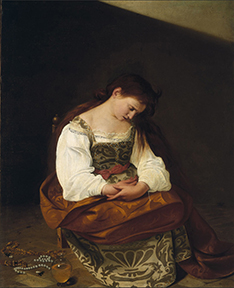
Caravaggio (for he was now generally called by the name of his native town) was making himself more and more notable for the color scheme which he was introducing, not soft and sparingly tinted as before, but reinforced throughout with bold shadows and a great deal of black to give relief to the forms. He went so far in this manner of working that he never brought his figures out into the daylight, but placed them in the dark brown atmosphere of a closed room, using a high light that descended vertically over the principal parts of the bodies while leaving the remainder in shadow in order to give force through a strong contrast of light and dark.
The painters then in Rome were greatly impressed by his novelty and the younger ones especially gathered around him and praised him as the only true imitator of nature. Looking upon his works as miracles, they outdid each other in following his method, undressing their models and placing their lights high; without paying attention to study and teachings, each found easily in the piazza or in the street his teacher or his model for copying nature.
This facile manner attracted many, and only the old painters who were accustomed to the old ways were shocked at the new concern for nature, and they did not cease to decry Caravaggio and his manner. They spread it about that he did not know how to come out of the cellar and that, poor in invention and design, lacking in decorum and art, he painted all his figures in one light and on one plane without gradations.
These accusations, however, did not retard the growth of his fame. Caravaggio painted the portrait of Cavalier Marino, the most famous among men of letters, and the names of the poet and the painter were thus celebrated together in the academies.

The Head of Medusa by Caravaggio, which Cardinal del Monte gave to the Grand Duke of Tuscany was particularly praised by Marino. Thus it happened that Marino, because of his good will toward Caravaggio and the pleasure which he took in his works, introduced him into the house of Monsignor Melchiorre Crescenzi, the clerk of the papal court. Michele painted the portrait of this most learned prelate and another one of Virgilio Crescenzi, who, as the heir of Cardinal Contarelli, chose him together with Giuseppino to execute the paintings in the chapel of S. Luigi dei Francesi.
Then something happened which greatly disturbed Caravaggio and almost made him despair of his reputation. After the central picture of St. Matthew [destroyed in Berlin in World War II] had been finished and placed on the altar, it was taken away by the priests, who said that the figure with his legs crossed and his feet crudely exposed to the public had neither decorum nor the appearance of a saint.
Caravaggio was in despair because of this affront to the first of his works in a church; however, the Marchese Vincenzo Giustiniani acted in his favor and freed him from this grief. He intervened with the priests, took the painting for himself, and had Caravaggio do another in a different way which is the one now seen above the altar.
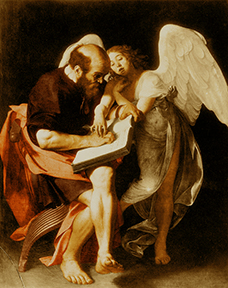 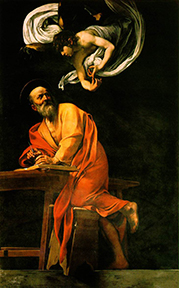
To show how much he honored the first painting he took it in his house, and later placed beside it paintings of the other three Evangelists: by Guido Reni, Domenichino, and Albani, the three most celebrated painters of the time. Caravaggio exerted every effort to succeed in his second picture; he tried to give a natural pose to the saint writing the gospel by showing him with one knee bent on the stool and with his hands on the small table in the act of dipping his pen in the inkwell placed on the book. He turns his face to the left toward the winged angel who, suspended in air, speaks to him and makes a sign to him by touching the index finger of his left hand with that of his right hand.
Caravaggio continued to be favored by the Marchese Vincenzo Giustiniani, who commissioned him to make some pictures, the Crowning with Thorns and St. Thomas placing his finger in the wound of the Lord's side; the Lord draws St. Thomas' hand closer to him and pulls the shroud away from His breast.
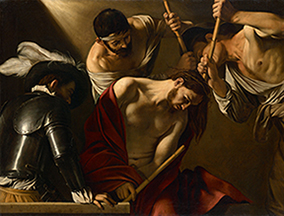 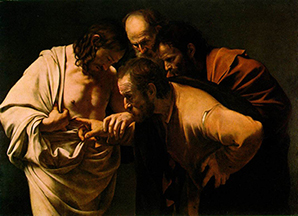
Besides th��������������������������������������������������������������������������������������������������������������������������������������������������������ese half-figures he painted a Victorious Amor raising his arrow in his right hand; arms, books, and other instruments are lying at his feet as trophies. Other Roman gentlemen were also pleased with his works and vied with one another to obtain them.
�
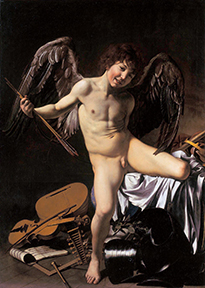 ��
��
Among them was the Marchese Asdrubale Mattei, who had him paint the Taking of Christ in the Garden, which is also in half-figures.
�
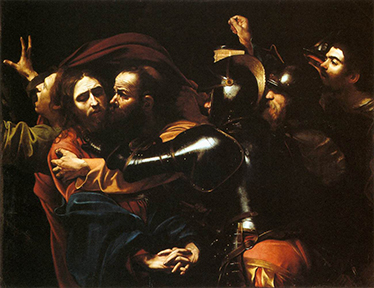 ��
��
For Massimi he painted an Ecce Homo which was taken to Spain, and for the Marchese Patrizi he did the Supper at Emmaus. Here Christ is blessing the bread and one of the apostles seated at the table recognizes Him and stretches out his arms while the other apostle rests his hand on the table and stares at Him in wonderment. Behind the table are the host with a cap on his head and an old woman who brings food.
�
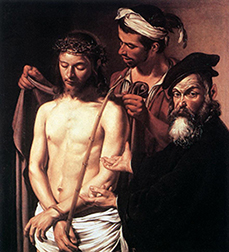 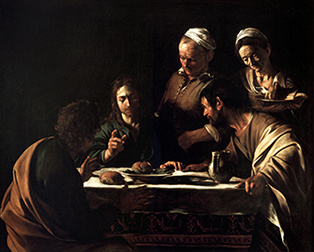
For Cardinal Scipione Borghese he painted a somewhat different version of the subject; the first is in deeper tones but both are praiseworthy for their imitation of natural color even though they lack decorum. For Michele's work often degenerated into low and vulgar forms.
For the same Cardinal he painted St. Jerome, who writes attentively, extending his hand to dip his pen in an inkwell; for him he also painted a half-length David holding by its hair the head of Goliath — Caravaggio's own portrait. David, who is shown grasping the hilt of his sword, is represented as a bare-headed youth with one shoulder out of his shirt. The picture has the bold shadows which Caravaggio liked to use to give force to his figures and compositions.
�
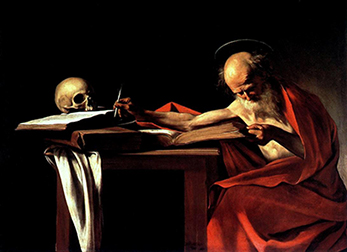 
Caravaggio's preoccupation with his painting did not calm the restlessness of his spirit. Having spent some hours of the day in his studio, he would appear in various parts of the city with his sword at his side as though he were a professional swordsman, giving the impression that he attended to everything but painting.
In a ball game, he had an argument with one of his young friends and they began to beat each other with the rackets. Finally, they resorted to arms, and Caravaggio killed the youth and was also wounded himself.
Having fled from Rome, penniless and pursued, he found refuge in Zagarolo under the protection of the Duke, Marzio Colonna. Afterward he went to Naples where he immediately found commissions because his manner and name were already known there.
In the chapel of the Signori di Franco in the church of S. Domenico Maggiore he was commissioned to do the Flagellation of Christ at the column. For the church of the Misericordia in the same city he painted the Seven Acts of Mercy, a painting about ten palmi long. Here one sees an old man who sticks his head out between the bars of a prison and sucks milk from the bared breast of a woman who bends down to him. Elsewhere in the painting appear the feet and legs of a dead man who is being carried to the sepulcher; the light from a torch carried by the man who supports the corpse shines on the white surplice of the priest, illuminating and giving life to the composition.
�
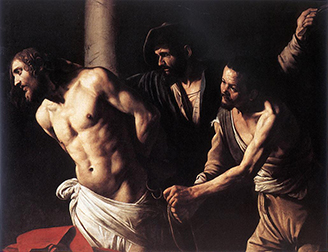 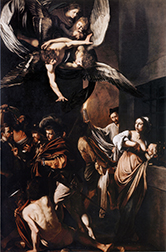
Caravaggio wished very much to receive the Cross of Malta which was usually given "per grazia" to notable persons for merit and virtue. He therefore went to Malta and, when he arrived, he was introduced to the Grand Master, Wignacourt, a French nobleman. Caravaggio portrayed him standing dressed in armor.
�

As a reward for this the Grand Master presented him with the Cross of Malta. For the Church of S. Giovanni he had him paint the Beheading of St. John who has fallen to the ground while the executioner, as though he had not quite killed him with the blow of his sword, takes his knife from his side and grasps the saint by the hair in order to cut off his head. Salome looks on with fascination, while an old woman with her is horror-stricken at the spectacle, and the warden of the prison, who is dressed in Turkish garb, points to the atrocious massacre. Caravaggio worked on his painting with such fervor that the priming shows through the half-tones.
�
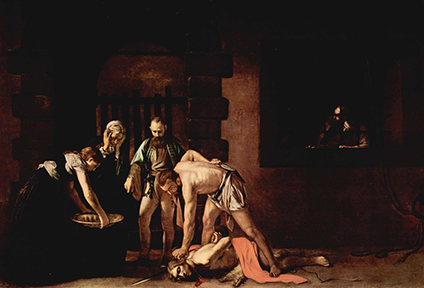
In addition to honoring Caravaggio with the Cross of Malta, our Grand Master gave him a precious chain of gold and two slaves along with other signs of his esteem and satisfaction with his work.
But all of a sudden his turbulent nature brought this prosperity to an end and caused him to loose the favor of the Grand Master; because of a very inopportune quarrel with a most noble Cavalier he was thrown into prison and was subjected to misery, fear, and maltreatment. With great personal danger, he managed to escape from prison in the night and fled unrecognized to Sicily with such great speed that he could not be overtaken.
He hurried across Sicily from Messina to Palermo and there, for the Oratorio di San Lorenzo he painted another Nativity, representing the Virgin contemplating the newborn Babe with St. Francis, St. Lawrence, St. Joseph seated, and an angel above. The lights are diffused among the shadows of the night.
�

When this work was finished he felt that it was no longer safe to remain in Sicily and so he left the island and sailed back to Naples, intending to remain there until he received news of his pardon so that he could return to Rome.
At the same time seeking to regain the favor of the Grand Master of Malta, he sent him as a gift a half-length figure of Salome with the head of St. John the Baptist in a basin. These attentions availed him nothing, for stopping one day in the doorway of the Osteria del Ciriglio he found himself surrounded by several armed men who manhandled him and gashed his face.
�
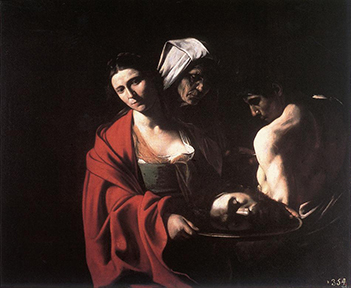
Thus as soon as it was possible, he boarded a felucca, and, suffering the bitterest pain, he started out for Rome.
Through the intercession of Cardinal Gonzaga he had already obtained his liberation from the Pope. When he went ashore the Spanish guard arrested him by mistake taking him for another Cavalier, and held him prisoner.
Although he was soon released, the felucca which was carrying him and his possessions was no longer to be found. Thus in the state of anxiety and desperation he ran along the beach in the full heat of the summer sun, and when he reached Porto Ercole he collapsed and was seized by a malignant fever.
He died within a few days at about forty years of age Thus Caravaggio finished his life and was buried on a deserted shore. Just when his return was awaited in Rome, came the unexpected news of his death.
Cavalier Marino, his very close friend, mourned his death and honored his memory with the following verses:
Nature, who feared to be surpassed In every image that you made Has, Michele, now, in league with Death, A cruel plot against you laid; For Death with indignation burned To know that many as his scythe Cut down, still more and usurously Your brush contrived to make alive.
There is no question that Caravaggio advanced the art of painting because he came upon the scene at a time when realism was not much in fashion and when figures were made according to convention and manner and satisfied more the taste for gracefulness than for truth.
Thus by avoiding all prettiness and vanity in his color, Caravaggio strengthened his tones and gave them blood and flesh. In this way he induced his fellow painters to work from nature.
He never introduced clear blue atmosphere into his pictures; on the contrary he always used black for the ground and depths and also for the flesh tones, limiting the force of the light to a few places.
Moreover, he followed his model so slavishly that he did not take credit for even one brush stroke, but said that it was the work of nature. He repudiated every other precept and considered it the highest achievement in art not to be bound to the rules of art.
Because of these innovations he received so much acclaim that some artists of great talent and instructed in the best schools were impelled to follow him.
With all this, many of the best elements of art were not in him; he possessed neither invention, nor decorum, nor design, nor any knowledge of the science of painting. The moment the model was taken away from his eyes his hand and his imagination remained empty.
Nevertheless, many artists were infatuated by his manner and accepted it willingly since without study or effort it enabled them to make facile copies after nature and to imitate forms which were vulgar and lacking in beauty. With the majesty of art thus suppressed by Caravaggio, everyone did as he pleased, and soon the value of the beautiful was discounted.
The antique lost all authority, as did Raphael, and because it was so easy to obtain models and paint heads from nature, these pictures abandoned the use of histories which are proper to painters and redirected themselves to half-length figures which were previously very little used.
Now began the representation of vile things; some artists began to look enthusiastically for filth and deformity. If they have to paint armor they choose the rustiest; if a vase, they do not make it complete but broken and without a spout.
The costumes they paint are stockings, breeches and big caps and when they paint figures they give all of their attention to the wrinkles, the defects of the skin and the contours, depicting knotted fingers and limbs disfigured by disease.
Because of this Caravaggio encountered much displeasure and some of his pictures were taken down from their altars, as we have said to be the case of San Luigi.
The same thing has happened to his Death of the Virgin in the Church of the Scala because it imitated too closely the corpse of a woman.
�
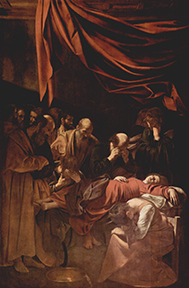
Another of his paintings, The Virgin and St. Anne, was taken down from one of the minor altars of the Vatican Basilica because the Virgin and the nude Christ Child were too indecently portrayed (as one can see in the Villa Borghese).
�

In Sant' Agostino, one is presented [with the Madonna of Loreto] with the dirt on the Pilgrim's feet and in Naples among the Seven Works of Mercy, there is a man who raises his flask to drink and lets the wine run into his open mouth in a coarse way.
�
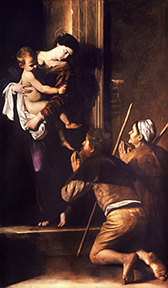
In the Supper at Emmaus, besides the rustic character of the two apostles and of the Lord who is shown young and without a beard, Caravaggio shows the innkeeper who serves with a cap on his head and on the table there is a plate of grapes, figs, and pomegranates out of season.
�
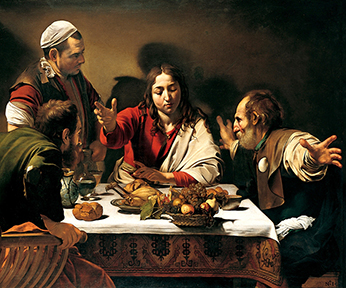
Caravaggio's way of working corresponded to his physiognomy and appearance. He had a dark complexion and dark eyes, black hair and eyebrows and this, of course, was reflected in his paintings.
His first manner, with its sweet and pure color, was his best; in it he made the greatest achievements and proved himself to be the most excellent Lombard colorist but later, driven by his peculiar temperament, he gave himself up to the dark manner, and to the expression of his turbulent and contentious nature.
Because of his temperament, Caravaggio was forced to leave Milan and his homeland and then to flee from Rome and from Malta, to go into hiding in Sicily, to live in danger in Naples and to die in misery on a deserted beach.
Caravaggio's colors are prized wherever painting is esteemed.
Top of Page
|
|
|

